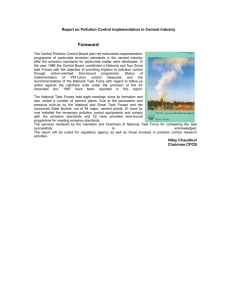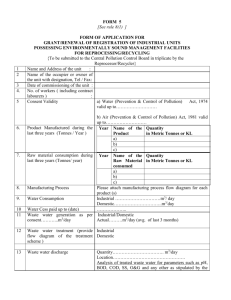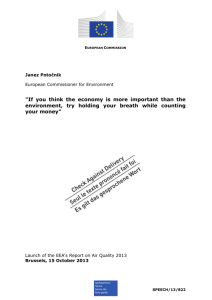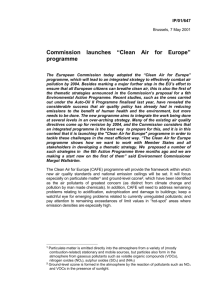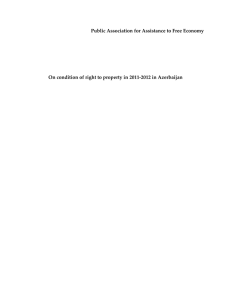npp_azerbaijan_summary_for_website
advertisement
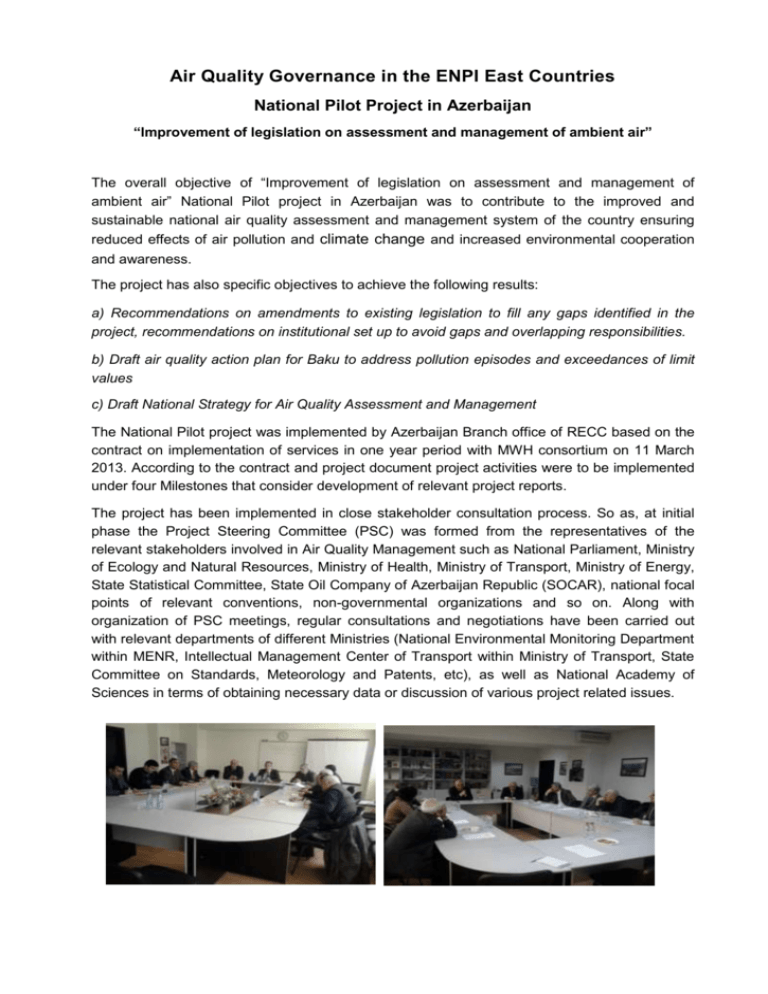
Air Quality Governance in the ENPI East Countries National Pilot Project in Azerbaijan “Improvement of legislation on assessment and management of ambient air” The overall objective of “Improvement of legislation on assessment and management of ambient air” National Pilot project in Azerbaijan was to contribute to the improved and sustainable national air quality assessment and management system of the country ensuring reduced effects of air pollution and climate change and increased environmental cooperation and awareness. The project has also specific objectives to achieve the following results: a) Recommendations on amendments to existing legislation to fill any gaps identified in the project, recommendations on institutional set up to avoid gaps and overlapping responsibilities. b) Draft air quality action plan for Baku to address pollution episodes and exceedances of limit values c) Draft National Strategy for Air Quality Assessment and Management The National Pilot project was implemented by Azerbaijan Branch office of RECC based on the contract on implementation of services in one year period with MWH consortium on 11 March 2013. According to the contract and project document project activities were to be implemented under four Milestones that consider development of relevant project reports. The project has been implemented in close stakeholder consultation process. So as, at initial phase the Project Steering Committee (PSC) was formed from the representatives of the relevant stakeholders involved in Air Quality Management such as National Parliament, Ministry of Ecology and Natural Resources, Ministry of Health, Ministry of Transport, Ministry of Energy, State Statistical Committee, State Oil Company of Azerbaijan Republic (SOCAR), national focal points of relevant conventions, non-governmental organizations and so on. Along with organization of PSC meetings, regular consultations and negotiations have been carried out with relevant departments of different Ministries (National Environmental Monitoring Department within MENR, Intellectual Management Center of Transport within Ministry of Transport, State Committee on Standards, Meteorology and Patents, etc), as well as National Academy of Sciences in terms of obtaining necessary data or discussion of various project related issues. Within Activity 1 related to the development of the “Comprehensive overview and gap analysis of the existing legislative and institutional framework on AQAM” report, a general overview of current AQAM system in Azerbaijan at policy, legislative, institutional, instrumental and operational levels was provided. Along with this, the project team has carried out analysis of air quality policy and legislation such as regulations on air quality monitoring (methods in use, site selection, station numbers, and measured parameters) and modelling, regulations regarding data on emissions including air quality standards, pollution permits (sectors/types of industry encompassed currently by mandatory pollution permits, emission threshold values for mandatory pollution permits, and pollution taxation system), the management of emission data (data handling, storage and validation). On the other hand, the project team ensured analysis of tasks of institutions responsible for air quality management, responsibilities of air quality monitoring, collection of emission data, working with emission databases and running dispersion models and review of the national and international obligations and reporting on the air quality, analysis of the relevant European legislation regulating air quality and air emissions. It was gap analysis on current AQAM system in Azerbaijan at policy, legislative, institutional, instrumental and operational levels, including gaps and overlaps in responsibilities of institutions involved in assessment and management of air quality was carried out; as well as gaps in data handling and reporting were assessed. A team of project experts with the support of international expert has provided detailed analysis of air quality legislation and institutional basis and developed a comprehensive report that included conclusions and recommendations on how to improve it. Report on “Comprehensive overview and gap analysis of the existing legislative and institutional framework on AQAM” comprises of 5 sections including introduction providing information of the scope of the report and its objectives, analysis of current policy and legislation on air quality, including international reporting, air quality limit values, pollution permits, emission data and data reporting, as well as analysis of current air legislation in view of EU requirements, main gaps, approximation to EU directives, comparison of EU Directives with national legislation on air quality, key issues regarding Plan of Actions on Approximation of Legislation with that of the EU, analysis of institutional set-up, gaps and overlapping in the institutional set-up, and recommendations on improvement, existing air quality assessment and management system in Azerbaijan, including information on air quality modelling, monitoring network, measurement methods and quality criteria, data validation, dispersion modelling, national emission databases, fugitive and mobile sources, and, finally, main conclusions of analysis and recommendations on improvement of air quality legislation and institutional basis. Within Activity 2 related to preparation of Draft Action Plan of Baku city, overview and analysis of the existing AQ monitoring data for Baku (data of the past 5-10 years), including trend analysis and source contribution, as well as analysis of exceedances of air quality limits values were carried out. Along with this, analysis of the existing emission data has been done, including pollution permits issued in the area, share of industries without pollution permits, traffic data available, possible contribution from natural sources, emission data handling and storage. It was followed by overview of administrative and technical measures to address high air quality levels (legislation used and measures applied in case of exceedances of limit values and taxation), as well proposal of emission reduction measures, definition of long and short term air quality objectives for Baku and recommendations on increasing public awareness on air pollution. It should be noted that during preparation of the Action Plan all relevant state policy document and programmes have been assessed in order to find similarities. As example for such documents, it could be mentioned Azerbaijan 2020: look for the future concept, ‘State Program on the development of transport system in the Republic of Azerbaijan (2006–2015)’, ‘State Program on Development of Fuel and Energy Complex (2005-2015)’, ‘State Program on Renewable and Alternative Sources of Energy (2008–2015)’, ‘Regional Development Plan of Baku city’ and so on. The short-term objectives of the Action Plan are devoted to reducing concentration of main pollutants (NO2, SO2, CO, HF, formaldehyde) in the specific period of time, as well as introduction of EU priority pollutants – PM10, PM2.5, and benzene. The long term air quality objective of the Action Plan for Baku was formulated in direction of EU air quality limit values and target values, as stipulated by the Directive 2008/50/EC of the European Parliament and of the Council of 21 May 2008 on ambient air quality and cleaner air for Europe, should be fully met in the entire territory of Baku city by 31 December 2030. Based on above-mentioned objectives, measures (actions) were developed; these were grouped as technical, institutional and administrative, legislative, awareness raising, as well as improvement of urban planning. Technical measures include necessary measures in order to improve monitoring system to obtain relevant information to ensure effective planning, also such measures as relocating the enterprises from the city center or close to city center, application of the latest, low-emission technologies in the enterprises located in Baku city, expansion of metro transport network in Baku city, establishment of large parking areas near metro stations in the city entries, improvement of road infrastructure, and construction of new road junctions, underground or above ground pedestrian crossings and car parking areas for the elimination of traffic jams, arrangement of bike paths in the newly built road junctions and at existing roads, mainly in city center, development of intelligent transport management network regulating traffic in all the main roads of the city, bus route optimisation, arrangement of necessary infrastructure and supported use of hybrid and battery electric cars, supply of all public buildings (schools, kindergartens, universities, ministries, etc.) with central heating system, arrange, where possible, application of alternative energy for all public buildings (schools, kindergartens, universities, ministries, etc.) etc. As a following step, the Draft Action Plan for Baku City for improvement of air quality assessment and management will be submitted to the MENR for further consideration. Following this, MENR will submit Air Quality Action Plan for Baku City to the Cabinet of Ministers for further actions. Within Activity 3, Draft National Strategy on AQAM, the project team has developed an overview of the air quality problems in Azerbaijan, which focused on air pollutants to be addressed as a major concern, specification of air quality objectives for Azerbaijan, recommendations for the development of an advanced air quality assessment and management system for Azerbaijan, including technical and administrative measures and improvement of data flows and use of resources, as well as recommendations on improvement of air quality assessment and management system. As for Draft Action Plan for Baku city, during preparation of the Draft Strategy on AQAM assessment of existing state programs and plans related to air quality management was done. Developed report comprises of 6 sections, including information on air quality objectives, overview of air pollutants relevant to Azerbaijan, current air quality policies, international commitments, national air quality policy, as well short-term and long-term objectives, air quality assessment and management system, including recommendations on air quality monitoring, air quality modelling, emission databases. Along with concrete objectives on reducing concentration of main pollutants, in Strategy Document includes a number on institutional objectives, such as introduction of EU Air Quality Standards, improved air quality management, improved data collection, analysis, storing and reporting, improved monitoring network covering all EU priority air pollutants, making air quality monitoring results available to public in real time, introduction of air pollution dispersion modelling for air quality assessment, improved inventory of emission sources and strengthened operator’s emission control. Recommendations on improvement of air quality assessment and management system have been grouped as recommendations on development of air quality monitoring, emission database, air quality modelling and legislation. In the field of development and modernisation of air quality monitoring system it is recommended to revise the air quality standards and harmonise them with those applied in the EU, approximate current air legislation to EU directives and upgrade legislative normative base in line with new adopted air quality standards, build capacity of the Air Quality Department and National Monitoring Department within the Ministry of Ecology and Natural Resources, collect environmental monitoring data into an electronic online data base, upgrade monitoring network with automated monitoring stations and improve public access to monitoring data through dissemination of real time information. Regarding recommendations on improvement of air quality modelling and development of emission databases, it was suggested to improve institutional capacity for air pollution dispersion modelling and for emission inventory, introduce advanced air quality assessment methods, develop modern normative base for air pollution dispersion modelling in line with the EU legislation, establish a comprehensive framework for collection and, where necessary, dissemination of metadata or detailed information about the emission sources and environmental conditions, ensure resources sufficient for preparing a digital map of pollution sources and adopt new guidelines for calculation of the emissions from stationary and mobile sources, introduce modernised methodology of emission inventories covering also small businesses, households and diffused sources of emissions and advanced methodology of assessment of emissions from mobile sources, review the system of administrative sanctions and fines for non-compliance of air pollution limit values with the aim to make it more consistent, proportionate and efficient, develop detailed rules for environmental monitoring by enterprises, as well develop the database accessible to all interested public authorities. Finally, the draft National Strategy recommends significant amendments to the existing legal acts and development of several new ones, all in line with the European air quality management related legislation. It is obvious that preparation of Strategy on Air Quality Assessment and Management is only the first step. Final revised version of the Strategy Document will be submitted to the MENR for further consideration. Following this, MENR will submit Air Quality Strategy to the Cabinet of Ministers for further actions. In overall, implemented activities within current project and achieved outputs creates good perspectives and paves way for further planning of set of actions related to the improvement of air quality legislation, as well air quality assessment and management.

